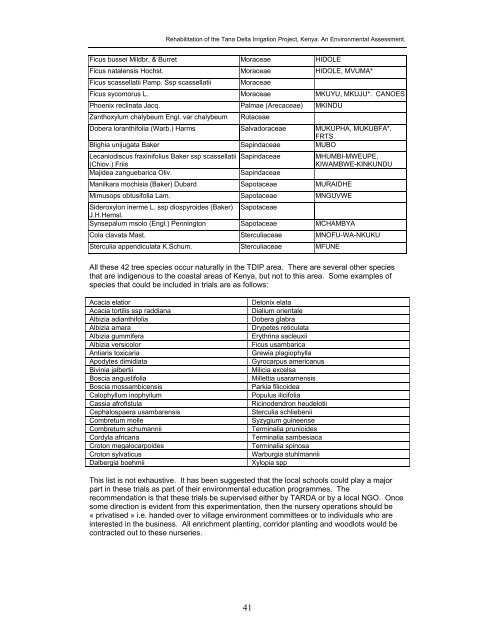Tana Delta Irrigation Project, Kenya: An Environmental Assessment
Tana Delta Irrigation Project, Kenya: An Environmental Assessment
Tana Delta Irrigation Project, Kenya: An Environmental Assessment
You also want an ePaper? Increase the reach of your titles
YUMPU automatically turns print PDFs into web optimized ePapers that Google loves.
Rehabilitation of the <strong>Tana</strong> <strong>Delta</strong> <strong>Irrigation</strong> <strong>Project</strong>, <strong>Kenya</strong>: <strong>An</strong> <strong>Environmental</strong> <strong>Assessment</strong>.<br />
Ficus bussei Mildbr. & Burret Moraceae HIDOLE<br />
Ficus natalensis Hochst. Moraceae HIDOLE, MVUMA*<br />
Ficus scassellatii Pamp. Ssp scassellatii Moraceae<br />
Ficus sycomorus L. Moraceae MKUYU, MKUJU*. CANOES<br />
Phoenix reclinata Jacq. Palmae (Arecaceae) MKINDU<br />
Zanthoxylum chalybeum Engl. var chalybeum Rutaceae<br />
Dobera loranthifolia (Warb.) Harms Salvadoraceae MUKUPHA, MUKUBFA*.<br />
FRTS<br />
Blighia unijugata Baker Sapindaceae MUBO<br />
Lecaniodiscus fraxinifolius Baker ssp scassellatii Sapindaceae<br />
MHUMBI-MWEUPE,<br />
(Chiov.) Friis<br />
KIWAMBWE-KINKUNDU<br />
Majidea zanguebarica Oliv.<br />
Sapindaceae<br />
Manilkara mochisia (Baker) Dubard Sapotaceae MURAIDHE<br />
Mimusops obtusifolia Lam. Sapotaceae MNGUVWE<br />
Sideroxylon inerme L. ssp diospyroides (Baker) Sapotaceae<br />
J.H.Hemsl.<br />
Synsepalum msolo (Engl.) Pennington Sapotaceae MCHAMBYA<br />
Cola clavata Mast. Sterculiaceae MNOFU-WA-NKUKU<br />
Sterculia appendiculata K.Schum. Sterculiaceae MFUNE<br />
All these 42 tree species occur naturally in the TDIP area. There are several other species<br />
that are indigenous to the coastal areas of <strong>Kenya</strong>, but not to this area. Some examples of<br />
species that could be included in trials are as follows:<br />
Acacia elatior<br />
Acacia tortilis ssp raddiana<br />
Albizia adianthifolia<br />
Albizia amara<br />
Albizia gummifera<br />
Albizia versicolor<br />
<strong>An</strong>tiaris toxicaria<br />
Apodytes dimidiata<br />
Bivinia jalbertii<br />
Boscia angustifolia<br />
Boscia mossambicensis<br />
Calophyllum inophyllum<br />
Cassia afrofistula<br />
Cephalospaera usambarensis<br />
Combretum molle<br />
Combretum schumannii<br />
Cordyla africana<br />
Croton megalocarpoides<br />
Croton sylvaticus<br />
Dalbergia boehmii<br />
Delonix elata<br />
Dialium orientale<br />
Dobera glabra<br />
Drypetes reticulata<br />
Erythrina sacleuxii<br />
Ficus usambarica<br />
Grewia plagiophylla<br />
Gyrocarpus americanus<br />
Milicia excelsa<br />
Millettia usaramensis<br />
Parkia filicoidea<br />
Populus ilicifolia<br />
Ricinodendron heudelotii<br />
Sterculia schliebenii<br />
Syzygium guineense<br />
Terminalia prunioides<br />
Terminalia sambesiaca<br />
Terminalia spinosa<br />
Warburgia stuhlmannii<br />
Xylopia spp<br />
This list is not exhaustive. It has been suggested that the local schools could play a major<br />
part in these trials as part of their environmental education programmes. The<br />
recommendation is that these trials be supervised either by TARDA or by a local NGO. Once<br />
some direction is evident from this experimentation, then the nursery operations should be<br />
« privatised » i.e. handed over to village environment committees or to individuals who are<br />
interested in the business. All enrichment planting, corridor planting and woodlots would be<br />
contracted out to these nurseries.<br />
41

















